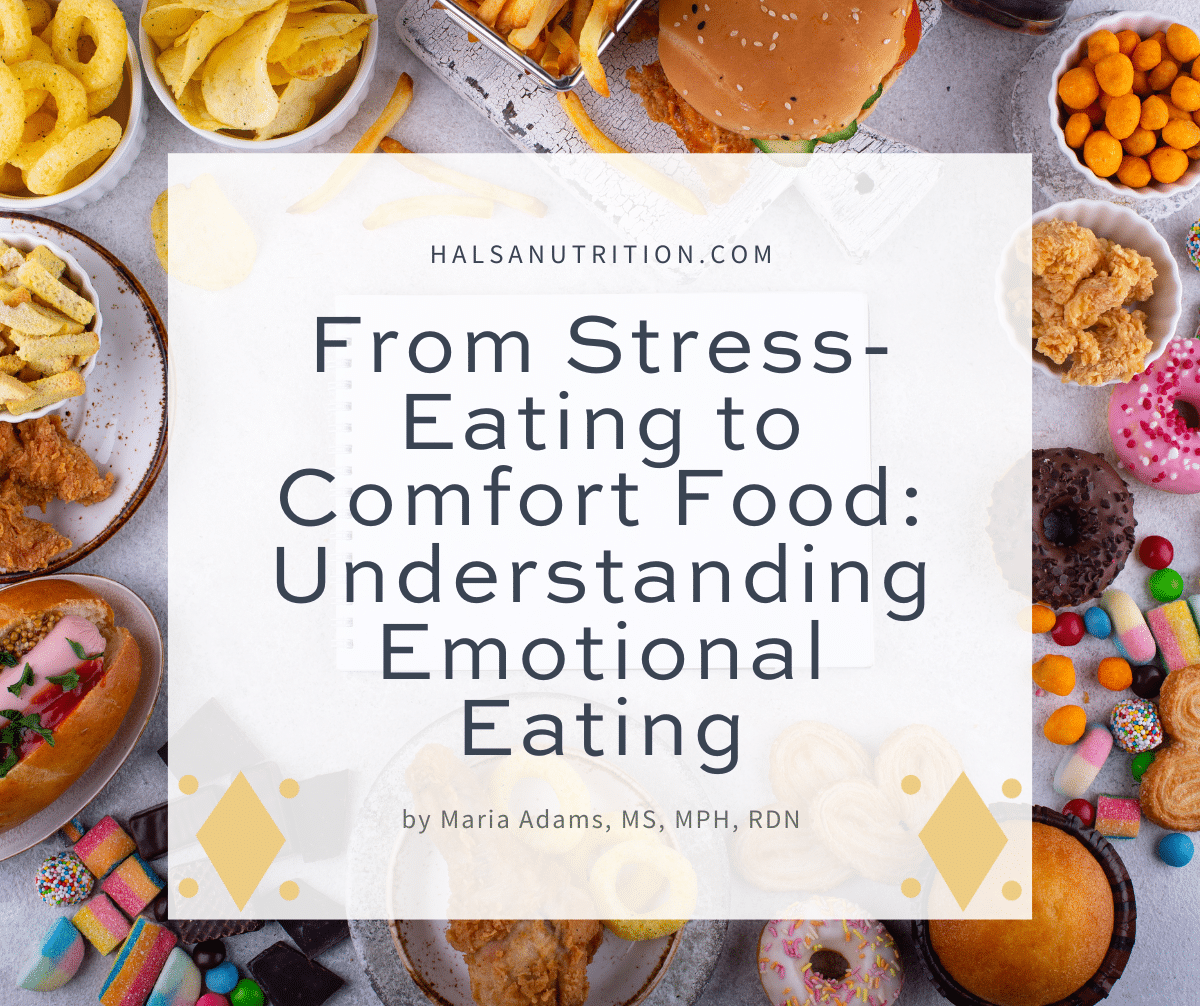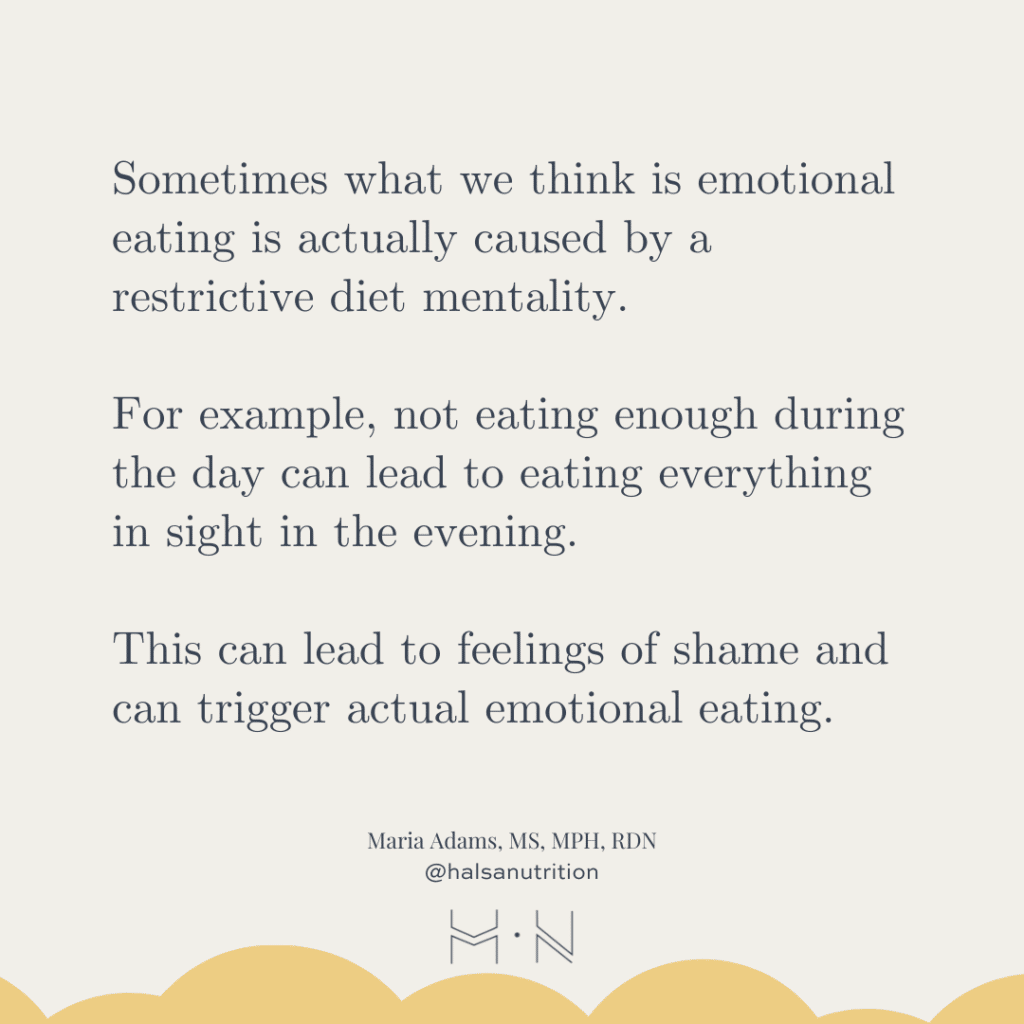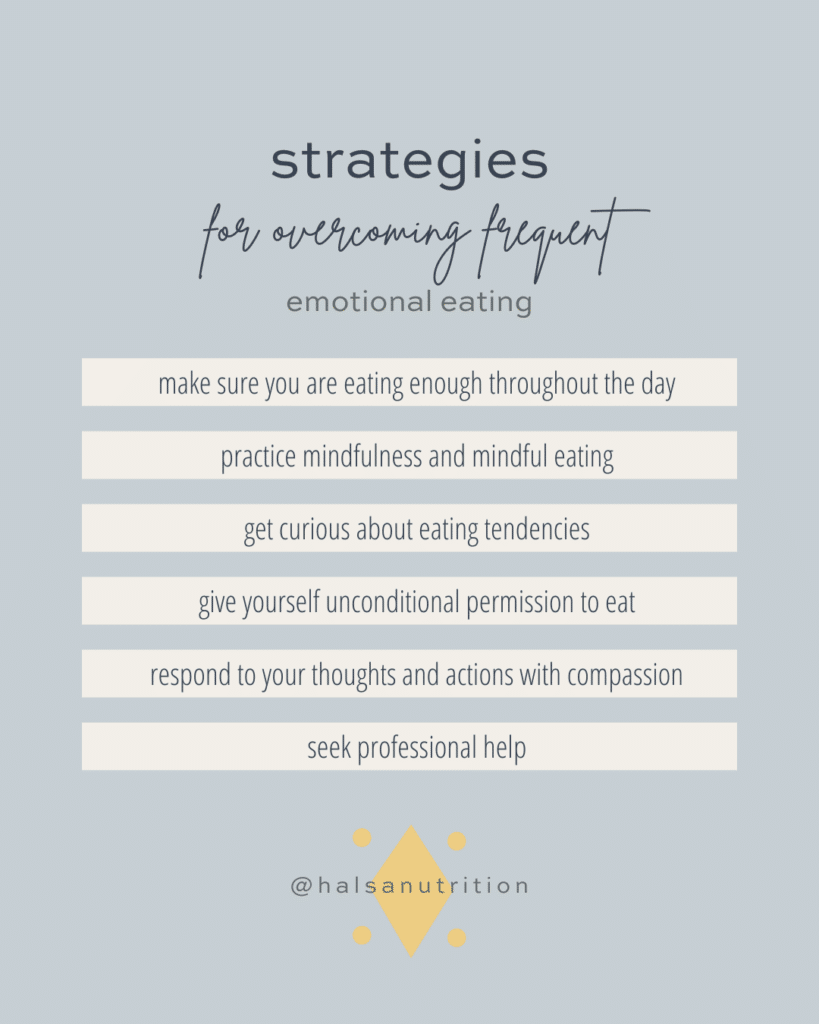
From Stress Eating to Comfort Food: Understanding Emotional Eating
Estimated reading time: 8 minutes
Have you ever had a tough day and turned to food for comfort? If so, you are not alone. According to one study, one-fifth of US adults report emotionally eating often or very often. (1)
Whether we are feeling sad, anxious, or stressed, turning to food for support makes a lot of sense. After all, food provides pleasure and can make us feel better, at least temporarily. Food is also a way to distract ourselves from the real issue at hand.
Fortunately, by developing a better understanding of the connection between our emotions and food choices–while also learning to treat ourselves with more compassion–we can make changes that lead to less frequent emotional eating and improved health and well-being.
The Science Behind Emotional Eating
Emotional eating is a complex phenomenon that involves both psychological and physiological factors. When we’re under stress, we are in sympathetic mode also known as “fight-or-flight.” Our body reacts by producing cortisol, also known as the “stress hormone”. Cortisol triggers the release of glucose into our bloodstream so that we will have the energy to deal with the stressful situation. This can lead to an increased appetite and cravings for high-calorie foods.
Additionally, the neurotransmitter dopamine is also involved in emotional eating. When we eat foods that are high in sugar and fat, our brain releases dopamine, which can provide temporary feelings of pleasure and comfort. This can create a continuous cycle, where we turn to food as a way to feel better, but end up feeling worse in the long run.
It’s important to note that emotional eating is not due to weakness or a lack of willpower, but rather a coping mechanism that humans have developed over time. (Of course, it would be fair to argue that evolution has not kept up with all the modern-day stresses that often lead to chronic stress).

Common Triggers of Emotional Eating
There are many different triggers that can lead to emotional eating. Some of the most common include stress, anxiety, boredom, loneliness, and sadness. For example, we may turn to food when we’re feeling overwhelmed with work, or when we’re home alone on a Friday night. These triggers can be both external, such as a stressful event or a difficult situation, or internal, such as negative self-talk.
It’s important to recognize your own personal triggers for emotional eating so that you can develop strategies to manage them. For example, if you know that you tend to reach for food when you’re feeling anxious, you can try to find alternative ways to soothe yourself, such as taking a walk, calling a friend, journaling, or practicing deep breathing or meditation.
The Effects of Emotional Eating on Health
While occasional emotional eating is not a concern, frequent emotional eating can have a number of effects on our health. Emotional eating may make us more likely to overeat, this can lead to issues such as lethargy, heartburn, bloating, and trouble sleeping. In the long term, overeating may increase your risk of heart disease and type 2 diabetes, among other health conditions. In addition to physical changes, emotional eating can also impact our mental health. It can lead to feelings of guilt, shame, and low self-esteem, which can further contribute to the cycle of emotional eating.
Moreover, emotional eating can interfere with our ability to regulate our hunger and fullness cues. When we eat in response to emotions rather than physical hunger, we may not be able to accurately gauge when we’re actually hungry or full. This can lead to reduced interoceptive awareness which makes intuitive eating difficult. (2)
Finally, emotional eating can also interfere with our ability to enjoy food and eat. When we’re focused on using food as a way to cope with emotions, we may not be fully present during meals or savor the flavors and textures of our food. This can lead to a disordered relationship with food and a lack of enjoyment in eating.
How to Identify Emotional Hunger vs. Physical Hunger
One of the keys to overcoming emotional eating is learning to distinguish between emotional hunger and physical hunger. Emotional hunger is often sudden and intense, and it may be accompanied by specific cravings for certain foods. Additionally, emotional hunger may be triggered by a specific emotion or situation, such as stress or boredom.
In contrast, physical hunger typically develops gradually over time, and it may be accompanied by physical symptoms such as stomach growling or lightheadedness. Physical hunger is also satisfied by a variety of foods, rather than specific cravings for certain types of food.
Of course, it’s also possible to experience a combination of emotional and physical hunger. A common cause of this is having a restrictive diet mentality or not eating enough during the day and then wondering why you are eating everything in site in the evening. This ravenous appetite can lead to feelings of guilt and shame that trigger emotional eating.

In addition, there are several other types of hunger, including “practical hunger” and “taste hunger”. Read more about the different types of hunger here.
By learning to identify the type of hunger we are experiencing it’s easier to make more mindful and intentional choices about what we eat. If we’re feeling emotional hunger, we may also try to address the underlying emotion in another way, before turning to food as a way to cope.
Strategies for Overcoming Frequent Emotional Eating
By acknowledging and addressing the underlying emotions, we can learn to manage our stress through behavior and habit change. Overcoming frequent emotional eating is a process that takes time and practice. Here are some strategies that can help:
1 – Make sure you are eating enough throughout the day. As mentioned earlier, sometimes emotional eating is tangled up with hunger. Having a consistent eating pattern can help. Most people benefit from eating every 3-4 hours. If you are someone who forgets to eat lunch or a snack, strategies such as setting a reminder on your phone and packing a snack can help.
2 – Practice mindfulness and mindful eating. Mindfulness is a Buddhist concept that essentially means being fully aware of the present moment without judgment. Eating mindfully is one component of intuitive eating. It entails being aware of everything from what you are eating to how fast you are eating to why you are eating.
3 – Get curious. Once you are more mindful and aware of your tendency to eat for emotional reasons you can get curious about the cause. Consider the following questions:
“Why am I turning to food? Is there another activity that might make me feel better?”
“How would my body feel if I _________________?”
Consider restructuring your day so that you will have another activity planned during the time you tend to emotionally eat. For example, if you tend to stress eat before dinner, see if you can schedule a daily walk at that time. Observe whether this is helpful.
4 – Give yourself unconditional permission to eat
Of course, if you decide that you want the food, go ahead and eat it without guilt. Traditional diet culture advice often overlooks the fact that restriction usually leads to more cravings and feelings of guilt. So rather than denying yourself the food, give yourself unconditional permission to eat until satisfied!
5 – Respond to your thoughts and actions with compassion
Additionally, respond to your thoughts and actions with unconditional compassion. Treat yourself like you would a friend or loved one. Leave the negative critique behind and be kind to yourself. Life is not easy!
6 – Seek professional help.
While everyone eats emotionally now and then, if you find that it’s frequent or negatively impacting your mental or physical health, seek professional help. Overcoming an emotional eating habit is hard work but possible. Both intuitive eating-trained dietitians and therapists can help you develop individualized strategies to reduce emotional eating.

Conclusion
Food is more than fuel for our bodies, it can also be a source of comfort and emotional support. However, when we regularly use food as a way to cope with difficult emotions, it can lead to a cycle of emotional eating that can have negative effects on our physical and mental health. By understanding our hunger as well as the connection between our emotions and our eating habits, we can create healthier coping strategies.
Healthful and helpful strategies for emotional eating include making sure you are eating enough throughout the day, practicing mindfulness, getting curious, giving yourself unconditional permission to eat, responding to yourself with compassion, and seeking professional help. By developing healthier coping mechanisms we can break the cycle of emotional eating and improve our overall well-being.
Next steps
If you are interested in working with a dietitian to overcome emotional eating, you can schedule a free Discovery Call here! You will be able to ask questions and decide if our program is the right fit for you.
Sources
(1) Elran Barak R, Shuval K, Li Q, Oetjen R, Drope J, Yaroch AL, Fennis BM, Harding M. Emotional Eating in Adults: The Role of Sociodemographics, Lifestyle Behaviors, and Self-Regulation-Findings from a U.S. National Study. Int J Environ Res Public Health. 2021 Feb 11;18(4):1744. doi: 10.3390/ijerph18041744. PMID: 33670147; PMCID: PMC7916829. https://www.ncbi.nlm.nih.gov/pmc/articles/PMC7916829/
(2)Warschburger, P., Wortmann, H.R., Gisch, U.A. et al. An experimental approach to training interoceptive sensitivity: study protocol for a pilot randomized controlled trial. Nutr J 21, 74 (2022). https://doi.org/10.1186/s12937-022-00827-4 https://rdcu.be/ddN45
Leave a Reply